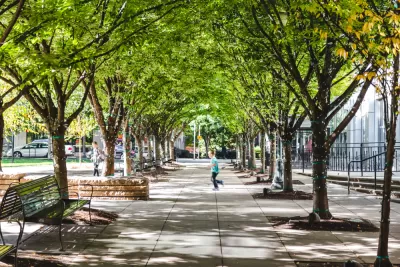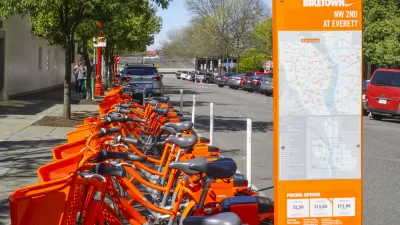Insight from Barcelona and Portland on how to plan and design an active, welcoming neighborhood square.

Dr. Suzanne H. Crowhurst Lennard writes with advice on how tot approach the planning of a neighborhood square, first distinguishing the neighborhood square from a city square:
Unlike a city’s main square that, from time to time, brings together representatives from all over the city for major festivals, concerts, and special events, a neighborhood square has certain unique social functions: it is frequented every day of the year by those who live in the neighborhood; it helps to strengthen social networks; and it builds community.
Those special functions require a special approach, according to Crowhurst Lennard. Those special functions are best embodied by European-style neighborhood squares. Successful examples in the Unnited States are scant, according to the article, Crowhurst Lennard cites the Conway Master Plan in NW Portland, launched over a decade ago, as a case study of a planning process focused on creating a neighborhood square.
The article proceeds to go into great depth about the proportions of the park, the heights of the surrounding buildings, and examines case studies from abroad, like Plaça del Raspali, Plaça del Diamant, and Plaça de John Lennon in Barcelona.
FULL STORY: Planning a Neighborhood Square

Trump Administration Could Effectively End Housing Voucher Program
Federal officials are eyeing major cuts to the Section 8 program that helps millions of low-income households pay rent.

Planetizen Federal Action Tracker
A weekly monitor of how Trump’s orders and actions are impacting planners and planning in America.

Ken Jennings Launches Transit Web Series
The Jeopardy champ wants you to ride public transit.

Crime Continues to Drop on Philly, San Francisco Transit Systems
SEPTA and BART both saw significant declines in violent crime in the first quarter of 2025.

How South LA Green Spaces Power Community Health and Hope
Green spaces like South L.A. Wetlands Park are helping South Los Angeles residents promote healthy lifestyles, build community, and advocate for improvements that reflect local needs in historically underserved neighborhoods.

Sacramento Plans ‘Quick-Build’ Road Safety Projects
The city wants to accelerate small-scale safety improvements that use low-cost equipment to make an impact at dangerous intersections.
Urban Design for Planners 1: Software Tools
This six-course series explores essential urban design concepts using open source software and equips planners with the tools they need to participate fully in the urban design process.
Planning for Universal Design
Learn the tools for implementing Universal Design in planning regulations.
Heyer Gruel & Associates PA
Ada County Highway District
Institute for Housing and Urban Development Studies (IHS)
City of Grandview
Harvard GSD Executive Education
Toledo-Lucas County Plan Commissions
Salt Lake City
NYU Wagner Graduate School of Public Service





























